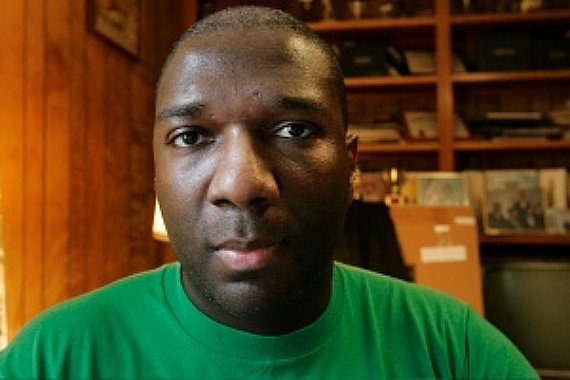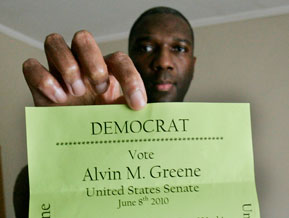Explaining Alvin Green’s Victory In South Carolina
Tom Jensen at Public Policy Polling has what I think may be the most plausible explanation of how an unknown, unemployed, former soldier with a pending felony charge managed to become the Democratic Party’s nominee for Senate in South Carolina:
Vic Rawl may on paper have clearly been the superior candidate but he wasn’t known much beyond political insider circles. When we polled the South Carolina Senate race two weeks before the primary Rawl had only 4% favorable name recognition with Democrats in the state. We could make up just about any name and ask their favorability on a poll and get 4% so that more or less amounts to zero name recognition.
In a contest where both candidates have no name recognition somebody’s going to win and people’s votes are going to be based on pretty random, nonintellectual judgments. I don’t put much stock in the theory that there was a plot among Republican voters to go cast votes for Greene in the primary or that the GOP in some other way helped Greene campaign…it would have been almost impossible for any sort of campaign activity to go completely undetected. At the end of the day this is just what happens in a race where neither candidate runs much of a campaign- someone wins and there’s no great explanation why.
Here’s the relevant question from the poll that was taken a mere two weeks before Tuesday’s primary:
 Two weeks before the election 82% of the people polled essentially knew nothing about Vic Rawl. If Alvin Greene had been polled at this point too, one would imagine his “Not Sure” number would have been even higher. So, basically, the Democratic primary ended up being a race between two complete unknowns and, as one writer for the Charleston City Paper puts it, anything was bound to happen:
Two weeks before the election 82% of the people polled essentially knew nothing about Vic Rawl. If Alvin Greene had been polled at this point too, one would imagine his “Not Sure” number would have been even higher. So, basically, the Democratic primary ended up being a race between two complete unknowns and, as one writer for the Charleston City Paper puts it, anything was bound to happen:
Rawl reportedly had $186,000 in his war chest, according noted liberal rag Mother Jones, while Greene may have paid only the $10,400 filing fee to run for the Senate and little else. But that was enough to win.
But $200 grand is a lot of money, you say.
Well, no, it’s not.
It is no where near the $3.5 million DeMint has in his war chest or what Barrett, McMaster, Bauer, and even Nikki Haley spent on campaigning.
According to a May 27 post on Wolfe Reports, Barrett had spent $1,127,641.46 between April 1 and the last election filing, McMaster $1,029,613.03, Bauer $943,315.55, and Haley $245,426.51. Each figure, which does not include the cash each candidate still had on hand, was well above what Rawl had in his entire war chest.
Simply put: $186,000 wasn’t enough to help Rawl get his name out there.
Believe you me, Rawl lost because voters had no idea who he was. When it comes to name recognition statewide, Rawl, despite being the better qualified candidate, was equal to Greene. And that meant Rawl was a nobody. (The same applies to Burton, who only managed to raise a few thousand bucks in his 1st Congressional District bid.)
So instead, the vote was decided by any number of factors, Greene’s placement on the ballot ahead of Rawl, a toss of the coin, a fondness for Alvin and the Chipmunks. Who knows?
There are still legitimate questions surrounding Alvin Greene, including where he got the $ 10,000 to pay the filing fee for the primary after reporting only four months earlier that he didn’t have enough money to pay for an attorney in his felony obscenity case, but it’s pretty clear that his victory has nothing to do with chicanery and everything to do with an opponent who was no more serious about winning than he was.
UPDATE (JAMES JOYNER): GW political scientist John Sides thinks the fact that Green’s name came first on the ballot may explain most of the outcome.
All I have to go on here is some guesswork, but it seems plausible to me that ballot order could be an important factor here. This was a very low information race, it would seem. Greene’s opponent, Vic Rawl, only raised $186,000 for his campaign, which isn’t much money for a statewide race. The low salience of the race is also evident in the roll-off: 169,542 voted in this race vs. 188,576 in the Democratic primary for governor.
And I’m not sure that the potential ballot order effect is implausibly large. Assume for the moment that voters were essentially choosing at random between the candidates. That would imply a 50-50 outcome. The actual outcome was 58-41, which only implies that 8-9% of voters were influenced by ballot margin.
Sides also looks at the possibility that race was a deciding factor, using the racial makeup of districts as a proxy, but found no statistically significant evidence.






It is phenomenal that so few people even heard of either of the two Democratic candidates for such a prestige office that late in the game. Granted, Jim DeMint is a virtual shoe-in for re-election, so it’s really a vanity primary. But yeesh.
I’m afraid we’re overlooking an obvious point.
Who wouldn’t want to vote for Al Green?
I think Kenny nailed it.
It certainly wouldn’t be the first time that a primary candidate won based upon the familiar sound of a name.
Maybe because his name sounds a lot better than “Vic Rawl?” Vic Rawl sounds like a vicious dog or something…